Solved Examples and Worksheet for ASA and AAS Postulates -Triangle Congruence
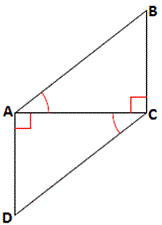
A. ΔACB ≅ ΔCDA
B. ΔABC ≅ ΔADC
C. ΔABC ≅ ΔDAC
D. ΔACB ≅ ΔCAD
Step: 1
If two angles and the included side of one triangle are congruent to the two angles and the included side of another triangle, then the two triangles are congruent.
Step: 2
As ∠CAB ≅ ∠ACD, ¯AC = ¯AC and ∠ACB ≅ ∠CAD, by ASA Postulate, we have ΔACB ≅ ΔCAD.
Correct Answer is : ΔACB ≅ ΔCAD
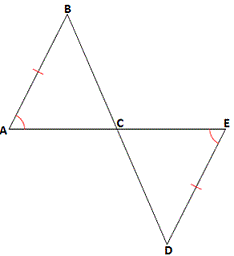
A. AAS postulate
B. ASA postulate
C. SAS postulate
D. SSS postulate
Step: 1
¯AB = ¯DE
[Given.]
Step: 2
∠BAC = ∠DEC
[Given.]
Step: 3
∠ACB = ∠ECD
[Vertical angles are congruent.]
Step: 4
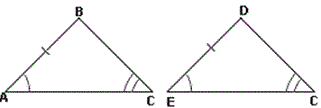
Step: 5
If the two angles and the non included side of one triangle are congruent to the two angles and the non included side of another triangle, then the two triangles are congruent.
[AAS postulate.]
Step: 6
Therefore, ΔABC ≅ Δ EDC by AAS postulate.
Correct Answer is : AAS postulate
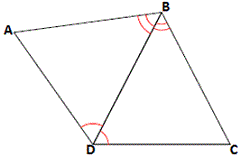
A. SAS postulate
B. SSS postulate
C. ASA postulate
D. AAS postulate
Step: 1
∠ADB = ∠CDB
[Given.]
Step: 2
∠ABD = ∠CBD
[Given.]
Step: 3
¯BD = ¯BD
[Reflexive property of congruence.]
Step: 4
If two angles and included side of one triangle are congruent to two angles and the included side of another triangle, then the two triangles are congruent.
[ASA postulate.]
Step: 5
Therefore, ΔABD ≅ ΔCBD by ASA postulate.
Correct Answer is : ASA postulate
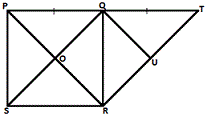
A. 3
B. 5
C. 6
D. 4
Step: 1
¯PQ = ¯QR = ¯RS = ¯SP
[PQRS is s square.]
Step: 2
¯PQ = ¯QT
[Given.]
Step: 3
⇒ ¯PQ = ¯QR = ¯RS = ¯SP = ¯QT
[From Step 1.]
Step: 4
All four angles of a square are equal to 90°. The diagonals of the square bisect its angles.
Step: 5
⇒ ∠OQP = ∠OPQ = ∠OQR = ∠ORQ = ∠ORS = ∠OSR = ∠OSP = ∠OPS = 45°
Step: 6
∠QRT = ∠QTR = 45°
[∠RQT = 90° and ¯QR = ¯QT.]
Step: 7
¯UQ bisects ∠RQT. So, ∠UQR = ∠UQT = 45°
[U is the midpoint of line segment RT.]
Step: 8
If two angles and included side of one triangle are congruent to two angles and the included side of another triangle, then the two triangles are congruent.
Step: 9
Therefore, ΔOPQ ≅ ΔOQR ≅ ΔORS ≅ ΔOSP ≅ ΔURQ ≅ ΔUQT.
Correct Answer is : 6
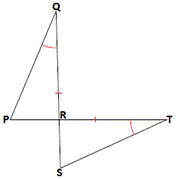
A. ASA postulate
B. AAS postulate
C. SAS postulate
D. SSS postulate
Step: 1
∠PQR = ∠STR
[Given.]
Step: 2
∠PRQ = ∠SRT
[Vertical angles are congruent.]
Step: 3
¯QR = ¯TR
[Given.]
Step: 4
If two angles and included side of one triangle are congruent to two angles and the included side of another triangle, then the two triangles are congruent.
Step: 5
Therefore, ΔPQR ≅ ΔSTR by ASA postulate.
Correct Answer is : ASA postulate

A. I only
B. II only
C. Either I or II
D. III only
Step: 1
∠CAB = ∠ZXY
[Given.]
Step: 2
∠ABC = ∠XYZ
[Given.]
Step: 3
If the two angles and the non included side of one triangle are congruent to the two angles and the non included side of another triangle, then the two triangles are congruent.
[AAS Theorem.]
Step: 4
The non included sides of ΔABC are AC, BC and that of ΔXYZ are XZ, YZ.
Step: 5
Therefore, ΔABC ≅ ΔXYZ if either ¯AC = ¯XZ or ¯BC = ¯YZ.
Step: 6
But, only the information ¯BC = ¯YZ will be need to prove that ΔABC = ΔXYZ by the AAS theorem.
Correct Answer is : II only
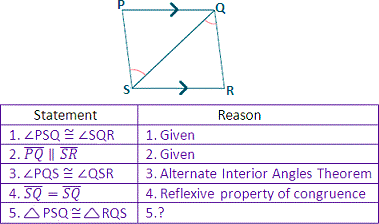
A. ASA postulate
B. AAS postulate
C. SAS postulate
D. SSS postulate
Step: 1
If two angles and included side of one triangle are congruent to two angles and the included side of another triangle, then the two triangles are congruent.
[ASA postulate.]
Step: 2
As ∠PSQ ≅ ∠RQS, ∠PQS ≅ ∠RSQ and ¯SQ = ¯SQ, by ASA postulate, we have ΔPSQ ≅ΔRQS.
Correct Answer is : ASA postulate
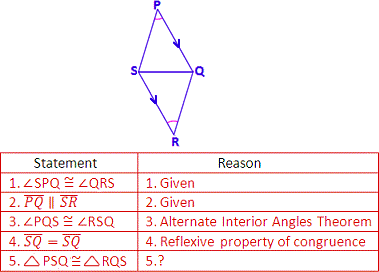
A. SSS postulate
B. ASA postulate
C. AAS postulate
D. SAS postulate
Step: 1
If two angles and a non included side of one triangle are congruent to the two angles and the non included side of another triangle, then the two triangles are congruent.
Step: 2
As ∠SPQ ≅ ∠QRS, ∠PQS ≅ ∠QSR and ¯SQ = ¯SQ, by AAS postulate, we have ΔPQS ≅ ΔRSQ.
Correct Answer is : AAS postulate
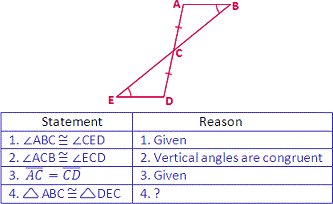
A. ASA postulate
B. AAS postulate
C. SAS postulate
D. SSS postulate
Step: 1
If two angles and a non included side of one triangle are congruent to the two angles and the non included side of another triangle, then the two triangles are congruent.
Step: 2
As ∠ABC ≅ ∠CED, ∠ACB ≅ ∠ECD and ¯AC = ¯CD, by AAS theorem, we have ΔABC ≅ ΔDEC
Correct Answer is : AAS postulate
Given : ¯AB ≅ ¯DE
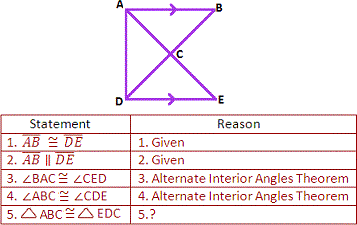
A. AAS postulate
B. SAS postulate
C. SSS postulate
D. ASA postulate
Step: 1
If two angles and included side of one triangle are congruent to two angles and the included side of another triangle, then the two triangles are congruent.
[ASA Theorem.]
Step: 2
As ∠BAC ≅ ∠CED, ∠ABC ≅ ∠CDE and ¯AB ≅ ¯DE, by ASA theorem, we have ΔABC ≅ ΔEDC
Correct Answer is : ASA postulate

A. SAS postulate
B. AAS postulate
C. SSS postulate
D. ASA postulate
Step: 1
If two angles and a non included side of one triangle are congruent to the two angles and the non included side of another triangle, then the two triangles are congruent.
[AAS Theorem.]
Step: 2
As ∠ADC ≅ ∠BDC, ∠CAD ≅ ∠DBC and ¯CD = ¯CD, by AAS theorem, we have ΔADC ≅ ΔBDC.
[AAS Theorem.]
Correct Answer is : AAS postulate
- Points, Rays, Angles, Lines and Line Segments-Geometry-Solved Examples
- Parallel Lines and Transversals-Geometry-Solved Examples
- Angle Sum Theorem and Medians in a Triangle-Geometry-Solved Examples
- Properties of Isosceles Triangles-Geometry-Solved Examples
- Proving Quadrilateral is a Parallelogram-Geometry-Solved Examples
- SSS and SAS Postulates-Triangle Congruence-Geometry-Solved Examples
- Transformations-Reflections-Geometry-Solved Examples
- Transformations-Rotations-Geometry-Solved Examples
- Transformations-Translations-Geometry-Solved Examples
Related Worksheet
- Saa Congruency Postulate

